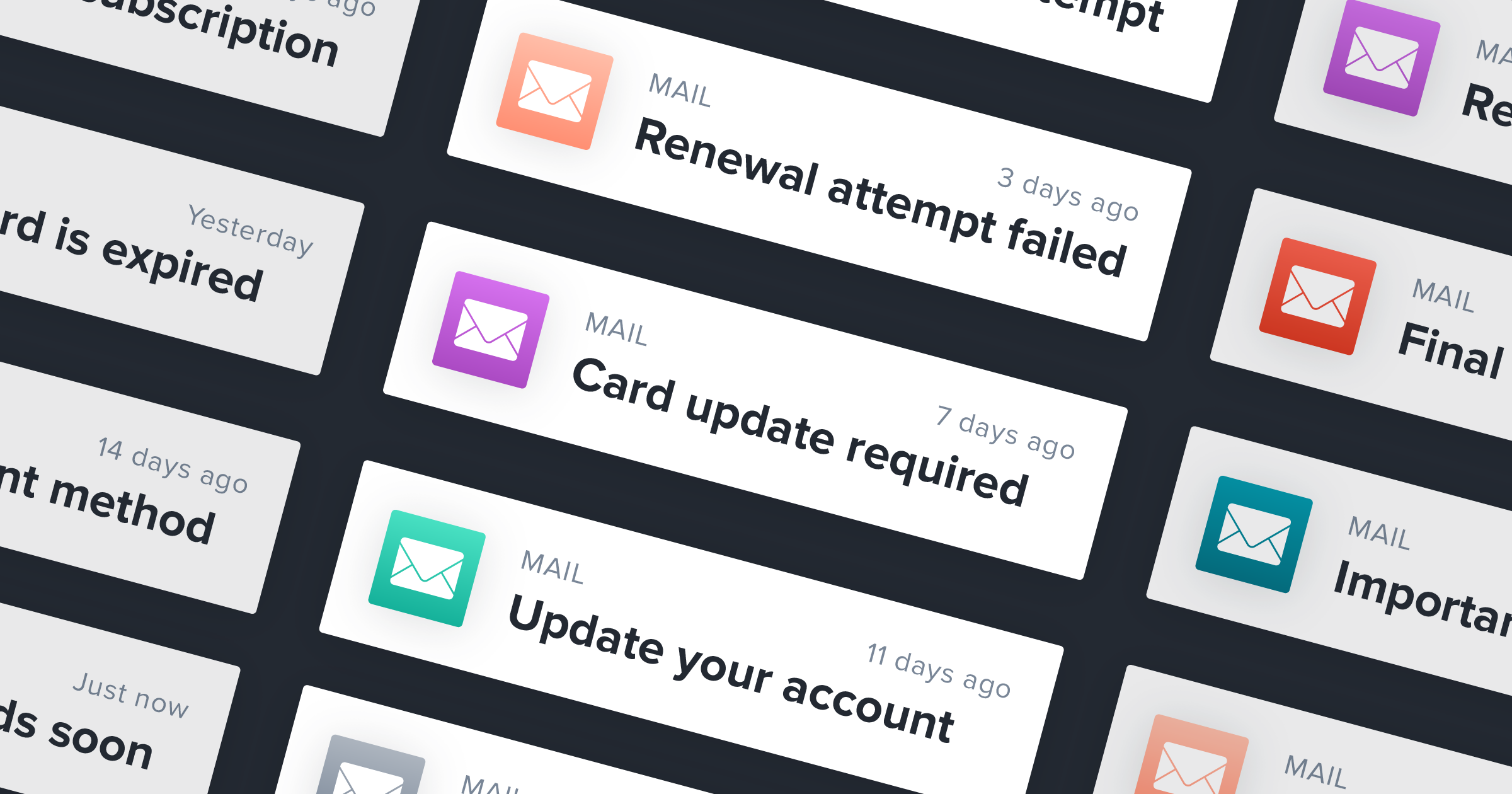Understanding the dunning process

According to Recurly’s comprehensive study on churn, subscription based businesses have an average involuntary churn rate of 1.0%. That may sound like a tiny percentage, but that’s the monthly rate. Over a full year, a large percentage of subscribers leave involuntarily—and it’s very possible to save them by taking the right steps.
There are three main ways that subscription management reduces involuntary churn: updating account details, intelligent retries, and dunning.
The first step is typically updating account details. By doing that, dunning software can prevent expired cards and cancellations from leading to hard declines.
If the credit card account details aren’t the culprit, it’s very possible that insufficient funds, credit/debit card restrictions, or technical issues could be responsible for the declined transaction. A subscription billing system uses a smart, data-driven approach to retry transactions at a time that is likely to lead to a high success rate.
In many cases, however, the first two approaches are unsuccessful. With customer satisfaction hanging in the balance, how do you serve a broad customer base with varying payment history? This makes personalized communication necessary to salvage the transaction: Enter dunning.
What is dunning?
Let’s define dunning. The dunning process refers to communicating with customers (usually via email) to arrange for the collection of overdue payments. This payment collection sounds like a simple and straightforward explanation of the payment reminders that the accounts receivable department sends.
But the optimization (or lack thereof) of the dunning process can have a significant impact on involuntary churn, not to mention late payments or payment failures. Meanwhile, an effective dunning process can lead to fewer overdue payments and prevent bad debt from starting a collections process, which isn’t a great customer experience.
To reduce involuntary churn from unpaid invoices, we have to move beyond the dunning meaning, and look at the dunning process—step-by-step.
How does the dunning process work?
There are five steps to dunning:
Step 1: Your customer’s invoice isn’t paid on time. Somehow, you have a late payment due to accounts receivable.
Step 2: Your subscription billing system sends a gentle reminder email alerting the customer that the payment method on file was declined. It provides instructions on how to update payment details to resolve the issue.
Step 3: The dunning software sends payment reminder emails or app notifications on a customized schedule and dunning level, based on your preferences. (This step is optional and a best practice to encourage timely payments.)
Step 4: If the dunning letters and other revenue recovery strategies are unsuccessful, the invoice fails. You can elect to cancel the subscription since you now have an overdue invoice and payment issues with this customer. Now their subscription doesn’t renew.
Step 5: You email the customer, letting them know that their subscription has been canceled. You also include a link to pay the invoice and re-subscribe, in case there is a change in circumstances.
Recurly's dunning software generates a strong ROI
Since dunning is a complex process, the dunning ROI provided by each subscription billing platform can vary dramatically. Recurly, with over a decade of experience in recurring billing across a number of industries, has created a customizable dunning process that gets results: Our platform has a 25% average recovery rate from dunning .
How does Recurly help its merchants recover revenue that would have otherwise been lost through dunning?
Here are a couple of ways:
Customized communications: Your company is unique, which means that your dunning process has to be unique, too. For example, an optimized dunning process for a B2B SaaS company is going to look a lot different than an optimized dunning process for a B2C consumer goods company. There may be more dunning levels depending on the industry and the size of the outstanding payments. In any case, you need more than billing software. You need a subscription billing platform, like Recurly, that has experience across industries.
Recurly separates the smart dunning and retry process: We separate the dunning and smart retry process because, again, not every company’s subscribers respond the same way to dunning emails. In addition, our past experience has indicated that the best time to attempt a payment retry varies by company.
How Recurly helps you streamline dunning
Recurly’s approach to revenue recovery has helped merchants report an average drop in involuntary churn from 6% to 1%. Our churn management model helps you:
Optimize dunning lengths or emails by plan
Vary dunning approach for trial vs. paying customer
Utilize web-hooks to manage dunning with a marketing automation platform
Get insights into the effectiveness of dunning performance
The first two features are geared towards further customizing the dunning process because targeting your communications to each group of customers is key to a successful dunning process.
By managing dunning with a marketing automation platform, you can reduce the burden on your staff. This allows you to redeploy them to higher-value tasks.
Finally, with insights into the effectiveness of dunning performance, you gain access to the data you need to constantly improve upon your dunning results.
Effective dunning strategies are key for subscription businesses to minimize churn, maximize revenue, and build long-term customer relationships. Want to learn more? Check out this guide from our team!


